How much time and money can a company save adapting UZIO AI Copilot?
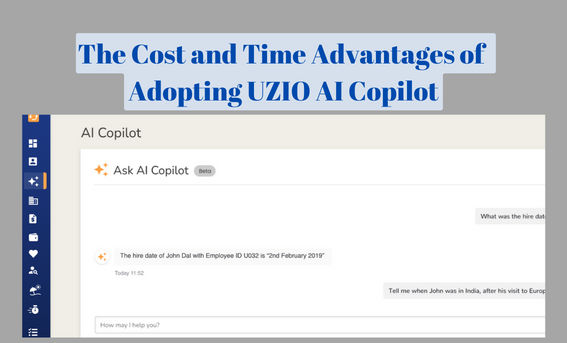
Quick links
-
Introduction to AI Copilot
-
Enhancing Efficiency in Data Retrieval
-
Impact on HR Productivity
-
Streamlining Compliance and Reporting
-
Cost-Benefit Analysis
-
Future Enhancements and Capabilities
-
Conclusion
1. Introduction to AI Copilot
In today’s fast-paced business environment, leveraging technology to streamline operations is not just an option but a necessity. UZIO AI Copilot represents a significant advancement in this direction, specifically tailored for the human resources sector. As part of UZIO’s comprehensive suite of HR, payroll, and benefits management solutions, the AI Copilot module is designed to enhance the efficiency and effectiveness of HR departments across various industries.
What is UZIO AI Copilot?
The UZIO AI Copilot is a state-of-the-art artificial intelligence tool integrated within UZIO’s existing platform. Launched in beta in April 2024, it utilizes advanced machine learning and natural language processing technologies to automate and answer complex HR queries. This AI tool is crafted to support not only employer users but, with future updates, also employee users, facilitating a wide range of HR functions from payroll queries to personal time off and employee information requests.
Importance of AI in HR Operations
Adopting AI in HR operations transforms traditional practices into more dynamic, responsive, and efficient processes. The AI Copilot specifically addresses common operational bottlenecks such as manual data entry, payroll management, and compliance reporting. By automating these tasks, companies can significantly reduce the hours spent on administrative work, allowing HR professionals to focus on more strategic and employee-centered activities. This shift not only improves the operational efficiency of HR departments but also enhances employee satisfaction and compliance adherence through more accurate and timely processing.
The UZIO AI Copilot is more than just a tool; it’s a transformative solution for companies looking to adapt to the evolving demands of workforce management while ensuring cost-effectiveness and reliability in their HR operations. As we delve deeper into the capabilities and benefits of this AI-powered tool, we can better understand how it stands to redefine time and cost savings for businesses across the US.
2. Enhancing Efficiency in Data Retrieval
The UZIO AI Copilot significantly enhances the efficiency of data retrieval within HR operations, streamlining what was traditionally a time-consuming task for HR and payroll managers. By providing a powerful query tool that can pull specific information directly from the enterprise database, the AI Copilot offers a substantial improvement over manual methods.
Rapid Access to Essential Data
HR and payroll managers often need to access a wide range of employee data, from personal details and job descriptions to payroll records and PTO balances. Traditionally, retrieving this information involved navigating complex database systems or manual record-keeping, which could be slow and error-prone. The UZIO AI Copilot simplifies this process by allowing users to ask direct questions and receive immediate answers. For example, a manager might query, “What is the current PTO balance for employee John Doe?” and receive an accurate response in seconds.
Reducing Dependency on Manual Processes
Before the implementation of AI tools like the UZIO AI Copilot, HR staff would typically spend hours compiling reports and cross-referencing data to ensure accuracy. This process not only consumed valuable time but also introduced the risk of human error, which could lead to misinformed decisions or compliance issues. With the AI Copilot, these risks are significantly mitigated. The tool pulls up-to-date and precise data from the enterprise’s synchronized HRIS database, reducing the workload and stress on human staff and minimizing errors.
Streamlining Routine HR Tasks
By automating data retrieval, the UZIO AI Copilot also helps in streamlining other routine HR tasks. For instance, preparing for audits, generating end-of-year reports, or reviewing compliance with labor laws can now be done with greater ease and less manual oversight. This not only frees up HR professionals to focus on more strategic initiatives but also enhances the overall efficiency of the HR department.
In summary, the UZIO AI Copilot’s capability to enhance efficiency in data retrieval transforms the foundational activities of HR departments. By providing rapid, accurate, and reliable access to essential data, the AI Copilot empowers HR and payroll managers to perform their roles with a higher degree of precision and confidence, thus improving the operational dynamics of the entire organization.
3. Impact on HR Productivity
The UZIO AI Copilot has a profound impact on HR productivity by streamlining data retrieval and analysis processes. This capability allows HR and payroll managers to focus more on strategic initiatives and less on the time-consuming tasks of data management.
Reducing Time on Data-Intensive Tasks
With the AI Copilot, HR professionals no longer need to manually gather and analyze vast amounts of data to identify trends in labor costs or payroll discrepancies. For example, when analyzing overtime expenses or fluctuations in benefit costs, the AI Copilot quickly provides detailed insights, such as identifying employees with significant overtime, like Devin Blackmore, or highlighting discrepancies in benefits contributions among employees. This automation significantly cuts down the time required to compile and analyze this information, freeing up HR staff for other critical tasks.
Enhancing Accuracy and Reducing Errors
Manual data analysis is prone to errors, which can lead to costly mistakes in payroll and compliance reporting. The AI Copilot minimizes these risks by providing accurate and consistent data analysis. Its ability to pull and process information from the enterprise database ensures that the data is up-to-date and reflective of the current situation, thereby enhancing the overall reliability of HR operations.
Facilitating Proactive HR Management
With quicker access to important data and insights, HR managers can be more proactive rather than reactive. For instance, by identifying high overtime costs early, the company can take timely measures to adjust staffing levels or redistribute workloads before it leads to burnout or affects employee morale. This proactive approach not only helps in managing costs but also supports a healthier work environment.
4. Streamlining Compliance and Reporting
Compliance with labor laws and organizational policies is a major responsibility for HR departments, requiring meticulous record-keeping and regular reporting. The UZIO AI Copilot significantly aids in these areas by automating and simplifying compliance and reporting tasks.
Automated Compliance Monitoring
The AI Copilot can continuously monitor data against compliance requirements, alerting HR managers to potential issues before they become problematic. This feature is particularly valuable in areas like overtime regulations and equal employment opportunity compliance, where non-compliance can result in significant penalties.
Simplifying Reporting Processes
Generating reports, a traditionally labor-intensive process, becomes streamlined with the AI Copilot. HR managers can query the system for specific compliance reports, such as EEOC or ACA compliance statuses, and receive formatted outputs ready for review and submission. This not only saves time but also ensures that reports are generated in a consistent and error-free manner.
Enhancing Data-Driven Decision Making
With easy access to accurate and comprehensive reports, HR managers can make more informed decisions. The AI Copilot’s ability to analyze and present data helps in identifying trends and patterns that may affect compliance or operational effectiveness, facilitating strategic planning and decision-making.
In conclusion, the UZIO AI Copilot’s impact on HR productivity and compliance is transformative. By automating data-intensive tasks and providing quick access to important insights, it enables HR professionals to operate more efficiently and proactively, while also ensuring that the organization remains compliant with all relevant regulations.
5. Cost-Benefit Analysis
Implementing the UZIO AI Copilot in HR operations presents a significant opportunity for organizations to optimize their resources and enhance financial efficiency. A comprehensive cost-benefit analysis reveals how the AI Copilot not only reduces operational costs but also provides a high return on investment (ROI) by improving various HR functions.
Reduction in Operational Costs
The AI Copilot drastically reduces the time HR and payroll managers spend on routine data retrieval and analysis tasks. For instance, the quick identification of labor cost trends, such as overtime expenses, alleviates the need for manual data processing and extensive overtime analysis. This efficiency translates into direct labor cost savings, as fewer hours are needed to manage data, and less reliance is placed on additional staff during peak payroll processing times.
Calculating ROI
To calculate the ROI of implementing the AI Copilot, consider the savings from reduced manual labor and the avoidance of compliance penalties against the cost of the AI system. Organizations typically find that the AI Copilot pays for itself within a few months through direct savings and improved operational efficiencies. Further, the intangible benefits, such as increased employee satisfaction and retention due to better-managed HR processes, also contribute to a positive ROI.
Long-Term Financial Impact
Over the long term, the AI Copilot helps sustain financial health by continuously optimizing HR processes. As the system learns and adapts to the company’s specific needs, it can offer increasingly refined suggestions for cost savings and efficiency improvements. This ongoing improvement cycle not only keeps the company competitive but also ensures that HR operations can scale effectively with minimal incremental cost.
The cost-benefit analysis of the UZIO AI Copilot demonstrates its value as a strategic investment. The initial costs are quickly offset by direct savings in labor and compliance-related expenditures, and the long-term benefits of improved efficiency and decision-making capacity highlight its role as a transformative tool in modern HR management.
6. Future Enhancements and Capabilities
As the UZIO AI Copilot continues to evolve, several planned enhancements and expansions are set to further enhance its functionality and impact on HR management. These future capabilities are designed to meet the growing and changing needs of businesses, aiming to provide even more comprehensive support and strategic insight.
Expanded Query Capabilities
One of the primary focuses for future updates is the expansion of the AI Copilot’s query capabilities. This enhancement will allow the tool to handle a broader range of HR functions, making it more versatile and useful across different aspects of HR management. By enabling more complex and varied queries, HR managers will be able to gain deeper insights and more detailed information, facilitating better decision-making and more effective management strategies.
Broader Access and User Engagement
Plans to expand access to the AI Copilot to include employee users will significantly increase its utility. Allowing employees to inquire directly about their payroll, employee information, and PTO via the AI Copilot will streamline communication and make data access faster and more efficient. This expansion is expected to improve user engagement and satisfaction by empowering employees with immediate access to their HR-related queries in straightforward, human-understandable language.
Customization and Flexibility
Finally, future updates will also focus on increasing the customization options available to users. This will allow the AI Copilot to be more finely tuned to meet the specific needs of different organizations. Customization can include everything from the specific types of reports generated to the way data is presented and analyzed. By offering greater flexibility, the AI Copilot will be able to serve a wider range of organizational needs, enhancing its effectiveness and the value it provides to users.
Recommended Reading: The Dawn of AI-First HRIS: UZIO Copilot’s Role in Redefining Efficiency and Decision Making
7. Conclusion
The UZIO AI Copilot is more than just a tool; it’s a transformative solution for HR management. By expanding its functionality, improving security, and increasing user access and customization, the AI Copilot is set to continue its role as a pivotal tool in the HR technology landscape, driving efficiency and strategic insight into HR operations. This ongoing development ensures that the UZIO AI Copilot remains at the cutting edge, helping businesses adapt to the evolving demands of workforce management while ensuring cost-effectiveness and reliability in their HR operations.
To know more about UZIO AI Copilot and get in touch with us for an expert-led demo.
Why should selecting a great Payroll/HR system be a top priority for an SMB?
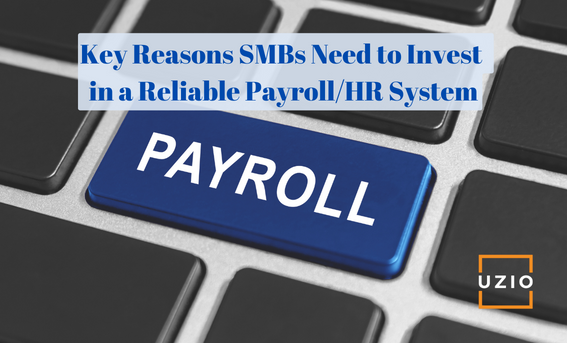
Quick links
-
Introduction
-
Strategic Advantages of Payroll/HR Systems
-
Compliance and Legal Implications
-
Enhancing Employee Experience and Engagement
-
Security and Data Protection in Payroll Systems
-
Debunking Common Myths
-
Conclusion
1. Introduction to Payroll/HR Systems for US SMBs
In the competitive landscape of small to medium-sized businesses (SMBs) in the United States, efficiency and compliance are not just goals—they are necessities for survival and growth. As an SMB owner or manager, you’re often tasked with making decisions that streamline operations without sacrificing quality or compliance. This is where a sophisticated payroll and human resources (HR) system can make a profound difference.
1. Why Consider a Payroll/HR System?
For many SMBs, payroll and HR tasks are time-consuming and fraught with the risk of errors. Whether it’s calculating overtime, managing benefits, or ensuring accurate tax deductions, these processes can quickly become overwhelming as your business grows. A robust payroll/HR system automates these tasks, reducing the likelihood of errors and freeing up your time so you can focus on core business activities.
2. Beyond Payroll Processing
Today’s payroll/HR systems offer much more than simple payroll processing. They integrate features such as HRIS (Human Resources Information System) and benefits management, creating a seamless ecosystem for managing your workforce effectively. These systems provide critical data that helps you make informed decisions about hiring, workforce costs, and benefits offerings. Additionally, they ensure that you stay compliant with ever-changing employment laws and tax obligations specific to your business location and industry.
3. The Right Tool for Every Size
It’s a common myth that only large corporations can benefit from or afford such systems. On the contrary, there are scalable solutions specifically designed for the needs and budgets of SMBs. These solutions not only accommodate current business sizes but also grow with the company, adapting to increased complexity as your employee count and operational needs expand.
As you navigate the subsequent sections of this blog, we will explore the strategic advantages, compliance benefits, cost-effectiveness, and essential considerations when choosing a payroll/HR system. Our goal is to equip you with the knowledge to make an informed decision about how such a system can benefit your business, ensuring that your operations are as efficient and compliant as possible.
2. Strategic Advantages of Payroll/HR Systems
When small to medium-sized businesses consider upgrading their operational tools, the decision must be strategic and impactful. Implementing a comprehensive payroll/HR system is one such decision that can transform your business. Here are the key strategic advantages these systems offer to SMBs:
1. Enhanced Decision Making with Data Analytics
In today’s data-driven world, having access to accurate and timely information is crucial for making informed decisions. Payroll/HR systems are equipped with analytics tools that provide insights into various aspects of your business. From understanding labor costs and overtime trends to analyzing employee turnover rates, these insights help you make strategic decisions that can lead to cost savings and improved employee retention.
Automation Reduces Errors and Saves Time
Manual payroll and HR processes are susceptible to human error, which can be costly in terms of both time and money. Automated systems reduce these risks significantly by ensuring that calculations are accurate and compliance with tax and employment laws is maintained. This automation frees up valuable time for your HR and finance teams, allowing them to focus on more strategic tasks rather than getting bogged down by routine paperwork.
2. Streamlined Employee Management
Modern payroll/HR systems streamline many aspects of employee management, from recruitment to retirement. By centralizing employee data in one place, these systems make it easier to manage employee records, track career progression, and administer benefits. This centralization not only improves operational efficiency but also enhances the employee experience by ensuring that their interactions with HR are smooth and productive.
3. Proactive Compliance Management
Keeping up with the myriad of federal, state, and local regulations can be a daunting task for any business. Payroll/HR systems help manage this by automatically updating their platforms in accordance with the latest legal requirements. This proactive approach to compliance management protects your business from potential fines and legal issues, and it ensures that you’re always a step ahead in terms of regulatory adherence.
4. Facilitating Remote Work
The ability to support a remote workforce has become a necessity, not a luxury, in the modern business environment. Payroll/HR systems facilitate this by providing cloud-based access to all necessary tools and information. Employees can view their pay stubs, request time off, or update their personal information from anywhere, at any time, which is particularly beneficial in today’s increasingly flexible work environments.
By leveraging these strategic advantages, a payroll/HR system not only supports but actively enhances the operational capabilities of an SMB. In the next section, we will delve into how these systems help ensure compliance with employment laws, a critical concern for every business owner.
3. Compliance and Legal Implications
For small to medium-sized businesses, navigating the complex landscape of employment laws and tax regulations is not just challenging—it’s a critical requirement for operational legality and success. A robust payroll/HR system plays an essential role in simplifying this aspect of business management. Here’s how such systems can help:
1. Ensuring Accurate Tax Filings
Payroll systems automate the calculation and withholding of federal, state, and local taxes. This automation helps prevent common mistakes such as underpaying or overpaying taxes. More importantly, it ensures timely filings, helping SMBs avoid penalties associated with late or incorrect tax submissions. By keeping track of changing tax rates and regulations, payroll systems provide peace of mind that your business remains compliant.
2. Adhering to Employment Laws
The United States has a myriad of employment laws that vary by state and even by city. This includes regulations on minimum wage, overtime pay, and sick leave accruals, among others. A good payroll/HR system updates its features to reflect these changes, ensuring that your business always adheres to current laws. This not only protects your business from costly legal actions but also supports fair workplace practices.
Managing Employee Benefits and Leave Policies
Compliance isn’t only about adhering to tax laws and employment regulations; it also involves the correct management of employee benefits like health insurance and retirement plans. Payroll/HR systems help administer these programs according to governmental guidelines and reporting requirements. Additionally, these systems manage various types of employee leave—such as FMLA, parental leave, and personal time off—ensuring that your policies comply with relevant laws.
3. Audit Trails and Record Keeping
An often overlooked aspect of compliance is the need for thorough record-keeping. Payroll/HR systems create detailed audit trails and maintain records for the required periods stipulated by law. This is invaluable in the event of audits or disputes, providing clear, easily accessible data that can substantiate your business’s compliance efforts.
4. Reducing the Risk of Penalties and Fines
By automating compliance features, payroll/HR systems significantly reduce the risk of facing penalties and fines due to non-compliance. This protective measure not only saves money but also shields your business’s reputation, ensuring that you are seen as a trustworthy and reliable employer.
In summary, a comprehensive payroll/HR system not only simplifies the intricate process of compliance but also acts as a safeguard, protecting your business from potential legal complications. This peace of mind allows you to focus more on growing your business and less on the nuances of regulatory adherence.
4. Enhancing Employee Experience and Engagement
A positive employee experience is crucial for fostering a productive, motivated, and loyal workforce. Implementing a sophisticated payroll/HR system can significantly contribute to this goal by improving several key areas of the employee lifecycle. Here’s how these systems benefit employees directly:
1. Timely and Accurate Payroll Processing
One of the most tangible ways a payroll/HR system impacts employees is through reliable and accurate payroll processing. Ensuring that employees are paid correctly and on time is fundamental to maintaining trust and satisfaction. Automated systems eliminate common payroll errors and delays, which are often sources of employee frustration in manual processes.
2. Self-Service Portals Enhance Independence
Modern payroll/HR systems often include self-service portals that empower employees to manage their personal information, view their pay stubs, request time off, and access HR documents independently. This autonomy can significantly enhance employee satisfaction as it provides them with control over their personal data and reduces the time spent on administrative queries.
3. Better Access to Benefits and Company Policies
An integrated payroll/HR system simplifies the management of employee benefits, from health insurance to retirement plans. These systems allow employees to easily enroll in benefits, update their choices, and understand their entitlements. Clear, accessible information about benefits and company policies also ensures that employees feel well-informed and valued by their employer.
4. Support for Career Development
HR systems play a crucial role in career development by tracking performance reviews, training opportunities, and promotion paths. These features help employees understand their progress and career prospects within the company, directly contributing to their engagement and motivation.
5. Improving Work-Life Balance
By facilitating more efficient management of time-off requests and supporting flexible working arrangements, payroll/HR systems contribute to a better work-life balance for employees. Easy access to scheduling tools allows employees to plan and manage their time more effectively, which is especially important in today’s dynamic work environments.
5. Security and Data Protection in Payroll Systems
In an era where data breaches are not just disruptive but potentially devastating to a business’s reputation and finances, the security of payroll and HR data is paramount. Here’s how modern payroll/HR systems address these challenges to protect sensitive employee information:
1. Robust Data Security Measures
Advanced payroll/HR systems are equipped with state-of-the-art security features including end-to-end encryption, multi-factor authentication, and secure data centers that comply with stringent regulatory standards like HIPAA and GDPR. These measures ensure that sensitive data such as social security numbers, salary information, and personal employee details are protected against unauthorized access.
2. Regular Security Updates and Compliance
To guard against emerging threats, reputable payroll/HR system providers continuously update their security protocols and software. This ongoing commitment helps protect businesses from the latest cyber threats and ensures compliance with current data protection laws, which is crucial in maintaining trust and legal compliance.
3. Controlled Access and User Permissions
Payroll/HR systems allow businesses to set detailed user permissions, ensuring that employees can only access the data necessary for their roles. This minimizes the risk of internal data breaches and ensures that sensitive information is not accessible to unauthorized personnel within the organization.
4. Data Backup and Recovery Systems
In the event of a system failure or data loss incident, having robust backup and recovery systems in place is essential. Payroll/HR systems typically include automatic backups that store data securely in multiple locations, ensuring that it can be quickly restored and that business operations can continue with minimal disruption.
5. Educating Users on Security Best Practices
Beyond the technical measures, payroll/HR systems often provide training and resources to educate users on security best practices. This education helps prevent security breaches that occur due to human error, such as phishing attacks or insecure password practices.
6. Addressing Myths About Cloud Security
There is a common misconception that storing data in the cloud is less secure than on-premises solutions. However, cloud-based payroll/HR systems often offer enhanced security measures due to the scalability and technological prowess of cloud service providers. These providers are able to deploy extensive resources towards securing their infrastructure, which can exceed the capabilities of individual businesses, particularly SMBs.
In summary, investing in a payroll/HR system with robust security features is essential not only for protecting against external threats but also for ensuring internal data integrity and compliance. This level of security fosters trust among employees and safeguards the business from potential legal and financial repercussions.
Comparing Payroll Systems vs. Manual Processes for SMBs
| Feature | Payroll System | Manual Processes |
|---|---|---|
| Time Efficiency | High (Automated calculations save time) | Low (Time-consuming calculations) |
| Accuracy | High (Reduced human error) | Moderate (Prone to human error) |
| Cost Over Time | Lower (Efficiency reduces long-term costs) | Higher (Inefficiencies increase costs) |
| Scalability | Excellent (Easily adjusts to business growth) | Poor (Requires more resources as business grows) |
| Compliance | Automated updates ensure compliance | Risky (Requires constant manual updates) |
| Employee Access | Easy access via self-service portals | Limited or no access |
| Data Security | High (Advanced security measures) | Variable (Depends on in-house measures) |
| Reporting | Comprehensive and customizable reports | Basic and time-consuming to compile |
| Integration with Other Systems | High (Designed for integration) | Low (Often requires manual entry) |
| Support and Maintenance | Ongoing support and updates provided | Dependent on in-house expertise |
6. Debunking Common Myths
When it comes to payroll and HR systems, misinformation can lead to hesitation. It’s important to clear up these misconceptions so that SMBs can make informed decisions about implementing these systems. Here are some common myths and the truths behind them:
Myth 1: Payroll Systems Are Only for Large Corporations
Reality: This is one of the most prevalent misconceptions. While large corporations certainly benefit from the efficiencies of payroll systems, SMBs stand to gain just as much. These systems are scalable and can be tailored to the needs of smaller businesses, helping them manage compliance, payroll, and HR tasks more efficiently than manual processes.
Myth 2: They Are Too Expensive for Small Businesses
Reality: Many payroll/HR systems are designed with the budget constraints of SMBs in mind. Providers often offer various pricing models that scale with the size of the business and the features required. Moreover, the return on investment, including time savings, reduced errors, and compliance with legal standards, often outweighs the initial costs.
Myth 3: Implementation Is Too Complex and Disruptive
Reality: While implementation does require planning and adjustment, it doesn’t have to be disruptive. Many vendors provide comprehensive support throughout the process, including training, data migration assistance, and customer service, making the transition as smooth as possible. With proper planning and the right team, the switch can be managed effectively.
Myth 4: Automated Systems Will Eliminate HR Jobs
Reality: Rather than eliminating jobs, payroll/HR systems enhance the HR function by automating routine tasks. This allows HR professionals to focus on more strategic and impactful areas of their role, such as employee engagement, talent development, and strategic planning, ultimately making their roles more critical and strategic.
Myth 5: Cloud-Based Solutions Are Less Secure
Reality: This myth persists despite evidence to the contrary. Reputable cloud-based payroll/HR systems often offer superior security features compared to what SMBs can typically afford on their own. These systems leverage advanced encryption, rigorous compliance certifications, and regular security audits to ensure data is protected.
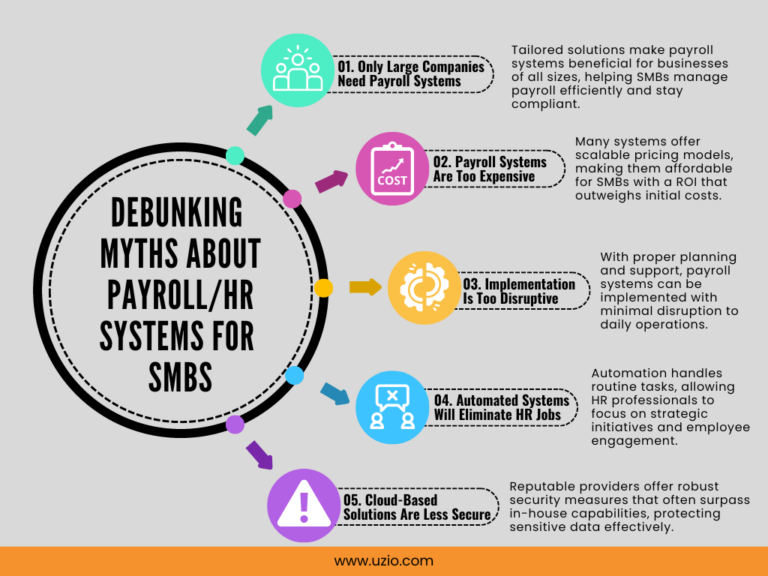
Recommended Reading: Biggest pain point with Payroll and HR software
7. Conclusion
Throughout this blog, we have explored the many ways in which a sophisticated payroll/HR system can transform a small to medium-sized business. From enhancing strategic decision-making and improving compliance to boosting employee satisfaction and safeguarding data, the benefits are clear and significant. These systems are not just administrative tools but strategic assets that can propel your business forward.
If you’re ready to take your business to the next level, consider UZIO—a leading provider of payroll, HRIS, and benefits solutions tailored for the unique needs of SMBs. UZIO is designed to simplify complex processes, ensure compliance, and enhance the overall employee experience, all while being cost-effective and scalable.
Moreover UZIO now integrates cutting-edge Artificial Intelligence (AI) and Machine Learning (ML) technologies to revolutionize HR, payroll, and benefits administration. The UZIO AI Copilot is here to transform your HR operations. This advanced AI-powered assistant can handle queries about Employee Information, Time Off Requests, and Payroll details with ease.
To know more about UZIO Payroll/HR solution and get in touch with us for an expert-led demo.
The Role of Cannabis Dispensaries in Community Development
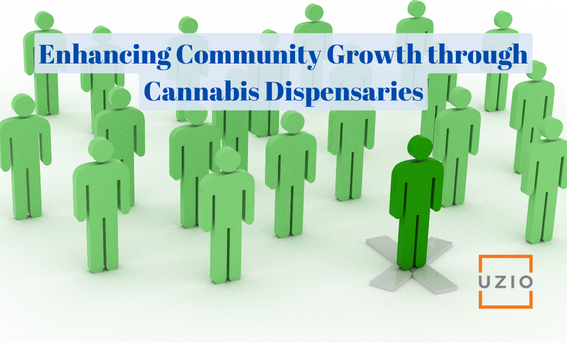
Quick links
-
Introduction to Cannabis Dispensaries and Their Growth
-
Economic Impact of Dispensaries on Local Economies
-
Case Studies of Economic Revitalization
-
Social Contributions and Community Engagement
-
Challenges and Controversies Surrounding Dispensaries
-
Future Outlook and Potential Developments
-
Conclusion
1. Introduction to Cannabis Dispensaries and Their Growth
Cannabis dispensaries have become a prominent fixture across the United States, evolving significantly with the legalization of medical and recreational cannabis. Initially established to serve patients requiring medical marijuana, dispensaries have expanded into recreational markets, catalyzing both economic and social transformations in their communities.
2. Economic Impact of Dispensaries on Local Economies
Dispensaries contribute significantly to local economies through job creation and increased business revenues. The cannabis industry has been a job engine, creating positions ranging from retail staff to security. This influx of jobs often leads to a ripple effect, boosting local economies. Property values in areas close to dispensaries have also seen an uptick, contrary to initial fears of decline.
3. Case Studies of Economic Revitalization
In regions like Colorado and California, dispensaries have played pivotal roles in revitalizing communities. For example, certain Colorado towns have reported increased tourism and higher local spending attributable to the presence of dispensaries. Interviews with economic development officers underscore the positive fiscal impact through increased tax revenues dedicated to public services and infrastructure improvements.
4. Social Contributions and Community Engagement
Beyond economic impacts, dispensaries actively engage in community development through various programs. Many organize educational sessions about responsible cannabis use and participate in public health initiatives, significantly contributing to community welfare.
Partnerships with Local Organizations
Cannabis dispensaries often collaborate with healthcare providers to educate on medicinal cannabis benefits, with schools on substance misuse programs, and with non-profits on community service projects. These partnerships help integrate dispensaries into the community fabric, promoting public health and safety.
5. Challenges and Controversies Surrounding Dispensaries
Despite the benefits, dispensaries face challenges, including community opposition and complex legal landscapes. Concerns often include fears about increased crime (though studies frequently debunk this), traffic, and changes in community character.
Navigating Community Relations
To improve community relations, many dispensaries take proactive steps such as hosting open houses, participating in community clean-ups, and involving community members in decision-making processes. Success stories of dispensaries overcoming initial resistance through transparency and engagement have become increasingly common.
6. Future Outlook and Potential Developments
Looking ahead, the role of dispensaries in community development is poised to grow. With continued legalization and destigmatization, dispensaries could play even more integral roles in their communities. Innovations in product offerings and business models, such as incorporating social equity programs, could further enhance their impact.
Recommended Reading: Top-7 Cannabis Trends to Watch out for in 2024
7. Conclusion
Cannabis dispensaries, once viewed with skepticism, have demonstrated substantial benefits to their communities through economic contributions and social engagement. As the industry matures, it holds the potential to play a pivotal role in shaping more vibrant, robust, and equitable communities. Leaders and policymakers are encouraged to consider these benefits and work towards regulatory frameworks that maximize the positive impacts of dispensaries on community development.
Get in touch with us for an expert-led demo to know more about UZIO all-in-one payroll software.
UZIO’s April 2024 Product Release – Exciting New Features!
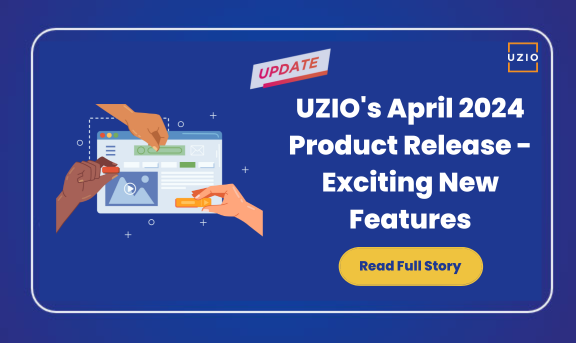
Great Falls, VA.
We’re thrilled to announce our April product updates, which now integrate cutting-edge Artificial Intelligence (AI) and Machine Learning (ML) technologies to revolutionize your HR, payroll, and benefits administration. These updates are designed to significantly enhance operational efficiency and security for all our users.
UZIO AI Copilot (Beta): Your Personal HR Assistant
Say goodbye to traditional HR management challenges! The UZIO AI Copilot is here to transform your HR operations. This advanced AI-powered assistant can handle queries about Employee Information, Time Off Requests, and Payroll details with ease.
Automated Medical Plan Data Entry for Brokers: AI-powered SBC Import
We are excited to roll out a groundbreaking feature for brokers—AI-powered SBC Import. This tool simplifies the medical plan setup process by automatically extracting and populating key details from Summary of Benefits and Coverage (SBC) documents.
Here’s how it simplifies your workflow:
- Upload SBC Data: Simply upload your client’s SBC file.
- AI-Powered Autofill: Our system analyzes the data and fills in the necessary fields.
- Review and Confirm: Check the details and confirm to complete the plan setup.
To watch demo of AI Copilot and AI-powered SBC Import, please click on the respective links. For any other query, please email info@uzio.com or give us a call at (866) 404-0284.
A word from the CEO:
“Right from the beginning, we have instituted a company culture where our team members make an extra effort to listen to the feedback from our customers and are always on the lookout for ways to improve the end user experience.” said Sanjay Singh, CEO of UZIO Technology Inc. “A number of enhancements in this release are the direct result of a collaborative working relationship we have with our customers where their feedback is listened to and given high priority as we make investment in our product roadmap.“
About UZIO Technology Inc.:
With over 150+ broker partners, 1700+ Employers relying on UZIO and 70+ carriers serving plans, UZIO offers an Integrated HR, Benefits Administration, and Payroll technology platform for brokers, employers, and employees in the SMB space. UZIO enables SMBs to manage HR and compliance with its user-friendly platform and advanced features.
Transforming HR Efficiency: The Power of AI in Document Processing

Quick links
-
Introduction
-
The Era of Manual HR Document Management
-
The Advent of AI in HR Document Processing
-
Benefits Beyond Efficiency
-
Overcoming Challenges and Limitations
-
The Future of AI in HR Document Management
1. Introduction
In the realm of Human Resources, managing documents has traditionally been fraught with inefficiencies and errors. HR departments have long been overwhelmed by manual tasks, from data entry to benefits paperwork. Enter Artificial Intelligence (AI), a revolutionary force poised to redefine HR document processing. With tools like UZIO AI Copilot, AI technology automates data extraction and processing, marking a pivotal moment in the evolution of HR efficiency.
2. The Era of Manual HR Document Management
In the not-so-distant past, the management of HR documents was an entirely manual affair, characterized by towering stacks of paper, rows of filing cabinets, and the constant click-clack of keyboards as HR professionals diligently entered data into spreadsheets or localized systems. This conventional approach to document management was not just a physical burden but a procedural one, demanding meticulous attention to detail and an inordinate amount of time.
Manual Processes and Their Drawbacks
- Data Entry and Updates: Manual entry of new hires, policy updates, or benefits changes is time-consuming and prone to errors.
- Document Filing and Retrieval: Physical documents require significant space and time to file and retrieve.
- Compliance and Reporting: Manual updates and reporting are fraught with the potential for oversight and error.
- Employee Queries: Manually searching documents to respond to employee inquiries adds to the HR workload.
Challenges Faced by HR Departments
- Time Consumption: The sheer volume of manual tasks consumed hours that could otherwise be spent on strategic HR initiatives, such as talent development or workplace culture enhancement.
- High Error Rates: Manual data entry and document management are inherently prone to human error. Even minor mistakes could lead to significant issues, from incorrect payroll processing to compliance violations.
- Inefficiencies: The manual handling of HR documents led to operational inefficiencies, with a considerable portion of HR resources dedicated to administrative tasks rather than strategic value-add activities.
- Limited Accessibility and Scalability: Physical document storage not only limited access to information (often confined to office hours) but also posed challenges in scaling HR operations to match organizational growth.
This era of manual HR document management, while foundational, highlighted the critical need for innovation and transformation. The limitations and challenges inherent in these traditional processes set the stage for the introduction of AI technologies, promising a new direction towards efficiency, accuracy, and strategic HR management.
3. The Advent of AI in HR Document Processing
AI technologies like natural language processing (NLP), machine learning (ML), and optical character recognition (OCR) have begun to transform HR document management. UZIO AI Copilot, at the forefront of this revolution, automates the HR document processing workflow, dramatically speeding up tasks and improving accuracy.
Key Features of AI-Driven Document Processing
The integration of Artificial Intelligence (AI) into HR document processing has introduced a suite of features that significantly enhance the efficiency and accuracy of HR operations. Among these, three key features stand out: Automated Data Extraction, Error Reduction, and Time Savings. Each of these features contributes to transforming the HR landscape, making processes more streamlined and reliable.
Automated Data Extraction
- How It Works: AI-driven document processing utilizes technologies like Optical Character Recognition (OCR) and Natural Language Processing (NLP) to scan, read, and understand the content of various HR documents. Whether it’s PDFs, scanned images, or digital forms, AI identifies and extracts key information such as employee details, plan benefits, and compliance requirements.
- Benefits: This automation eliminates the need for HR staff to manually input data from documents into HR systems. By directly extracting information like names, dates, and numerical data, AI ensures that essential data is captured accurately and efficiently, ready for further processing or analysis.
Error Reduction
- Impact of AI: One of the most significant advantages of AI in document processing is its ability to reduce errors associated with manual data entry. AI systems are designed to recognize patterns and learn from them, which means they can identify discrepancies or anomalies that might indicate a mistake. For instance, if an extracted date doesn’t follow a logical sequence (e.g., a termination date before a start date), the system can flag this for review.
- Improving Data Accuracy: By minimizing manual entry errors, AI not only ensures the integrity of HR data but also supports better decision-making based on accurate information. This level of precision is crucial for tasks like payroll processing, benefits administration, and compliance reporting, where errors can have significant repercussions.
Time Savings
- Efficiency Gains: The automation of data extraction and the reduction of errors lead to substantial time savings for HR departments. What once took hours of manual labor — sifting through documents, typing data into systems, and double-checking for mistakes — can now be accomplished in a fraction of the time.
- Reallocating Resources: These time savings allow HR professionals to redirect their focus from administrative tasks to more strategic initiatives. Whether it’s enhancing employee engagement, developing training programs, or analyzing workforce trends, AI frees up valuable resources to concentrate on areas that contribute to organizational growth and employee well-being.
Together, these key features of AI-driven document processing mark a significant advancement in the field of HR technology. By leveraging the capabilities of UZIO AI Copilot, organizations can not only streamline their HR document management processes but also elevate the role of HR within the company, shifting from administrative gatekeepers to strategic partners in business success.
4. Benefits Beyond Efficiency
The adoption of AI-driven document processing, exemplified by tools like UZIO AI Copilot, extends benefits far beyond mere operational efficiency. These technologies are reshaping the HR landscape in profound ways, enhancing employee satisfaction, enabling a strategic HR focus, and supporting scalability.
Employee Satisfaction
- Faster, more accurate document processing improves the employee experience, fostering a positive workplace environment.
Strategic HR Focus
- AI automation allows HR professionals to shift their focus to strategic initiatives, enhancing the department’s value.
Scalability
- AI document processing technologies support organizational growth, handling increasing volumes of data without a proportional increase in errors.
5. Overcoming Challenges and Limitations
While AI in HR document processing offers numerous advantages, it also presents challenges and limitations that organizations must navigate carefully.
Addressing Common Concerns
- Data Security: The use of AI in handling sensitive HR documents raises valid concerns about data security and privacy. Ensuring that AI systems are designed with robust security measures and comply with data protection regulations is paramount.
- Human Oversight: Despite the sophistication of AI technologies, human oversight remains crucial. HR professionals should review AI-processed data for accuracy and intervene in complex cases that require human judgment.
6. The Future of AI in HR Document Management
AI’s role in HR is set to expand, with future systems offering enhanced natural language processing, predictive analytics, and integration with emerging technologies. These advancements promise to automate compliance monitoring, personalize employee experiences, and provide enhanced decision support.
AI technologies like UZIO AI Copilot are transforming HR document management, automating tedious tasks, and enabling HR departments to focus on strategic initiatives. As AI continues to evolve, its potential to revolutionize HR practices grows, making the adoption of AI technologies a necessity for modern HR departments.
Get in touch with us for an expert-led demo to know more about UZIO all-in-one payroll software.
UZIO’s March 2024 Product Release – Exciting New Features!
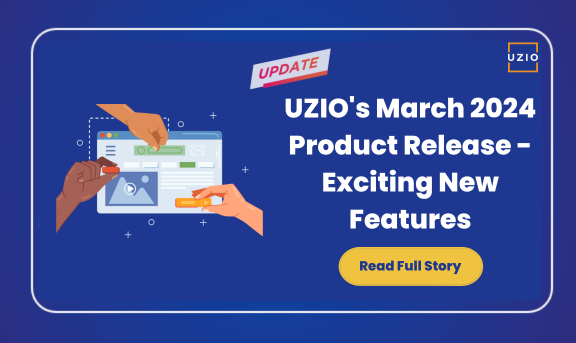
- Great Falls, VA. March 29th, 2024
We are thrilled to announce the latest updates and enhancements to the UZIO platform, aimed at streamlining your HR, Payroll, and Compliance processes to enhance your overall user experience. Here’s a summary of the key features included in this release:
UZIO HR Enhancements:
- Uzio HR Compliance Solution – New Launch
UZIO Payroll Enhancements:
- Setup Standard Occupational Classification (SOC) Codes for Payroll Compliance Reporting
- Reseller Partner Enhancements: New Tools for Streamlined Payroll Management
UZIO Time Off Enhancements:
- PTO Policy Accrual Maximum Available to Setup for Each Tenure
Miscellaneous Enhancements:
- SSN Mandatory for Employees of Payroll Client
- SSN Modification Restrictions for Employees
- Updated Work Location Selection Process for Adding Employees
For more details about any of these features, please click here. For any other query, please email info@uzio.com or give us a call at (866) 404-0284.
A word from the CEO:
“Right from the beginning, we have instituted a company culture where our team members make an extra effort to listen to the feedback from our customers and are always on the lookout for ways to improve the end user experience.” said Sanjay Singh, CEO of UZIO Technology Inc. “A number of enhancements in this release are the direct result of a collaborative working relationship we have with our customers where their feedback is listened to and given high priority as we make investment in our product roadmap.“
About UZIO Technology Inc.:
With over 150+ broker partners, 1700+ Employers relying on UZIO and 70+ carriers serving plans, UZIO offers an Integrated HR, Benefits Administration, and Payroll technology platform for brokers, employers, and employees in the SMB space. UZIO enables SMBs to manage HR and compliance with its user-friendly platform and advanced features.
The Dawn of AI-First HRIS: UZIO Copilot’s Role in Redefining Efficiency and Decision Making
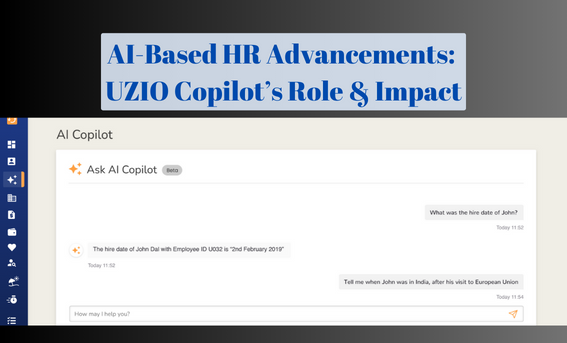
Quick links
-
Introduction
-
Understanding AI-First HRIS
-
Key Benefits of UZIO Copilot to the Stakeholder
-
Unlocking the UZIO Copilot Advantage
-
The Future of HRIS with UZIO
-
Conclusion
1. Introduction
In the evolving landscape of Human Resources Information Systems (HRIS), the advent of artificial intelligence (AI) heralds a pivotal shift. UZIO AI Copilot, at the forefront of this transformation, reimagines HR management by integrating AI at its core, offering a seamless, intelligent management system that enhances both operational efficiency and user satisfaction.
2. Understanding AI-First HRIS
The Essence of UZIO Copilot: An AI-First Philosophy
UZIO Copilot which is an AI enabled module in the UZIO platform represents a significant advancement in HR and payroll management, embracing an AI-first philosophy. This approach isn’t about merely incorporating AI features into an existing platform; it’s about gradually fundamentally redesigning the platform with AI and machine learning (ML) as its primary drivers. This ensures that UZIO Copilot provides intelligent automation across HR and payroll functions, streamlining operations and offering deeper insights for managing the workforce.
Challenges in Modern HR Addressed by AI
Today’s HR departments navigate a complex array of challenges, from the need for dynamic decision-making to ensuring regulatory compliance and fostering employee engagement. UZIO Copilot leverages AI to transform these challenges into opportunities, enhancing efficiency, compliance, and employee satisfaction by bridging the gap between traditional HRIS systems and the demands of the modern workplace.
https://vimeo.com/manage/videos/933307781
3. Key Benefits of UZIO Copilot to the Stakeholders
Operational Efficiency Enhanced by AI
UZIO Copilot transforms HR and payroll management by automating routine tasks and simplifying data analysis. This shift from manual processes to AI-driven automation facilitates a more efficient operational workflow, allowing HR professionals to focus on strategic initiatives rather than daily administrative tasks.
The capability of UZIO Copilot to understand and respond to a wide array of HR-related queries further exemplifies its impact on operational efficiency. Here are examples of questions that HR and payroll managers can seamlessly address through UZIO Copilot, showcasing the tool’s versatility and depth:
- How many employees are in the sales department?
- Who is the manager of the marketing department?
- What is the total payroll cost for the engineering department last month?
- Identify the top 5 highest-paid employees in the company.
- How many days of PTO does ‘Employee X’ have left?
- Who is currently on maternity leave?
- Calculate the gender diversity ratio within the company.
- Count how many employees identify as veterans.
These examples only scratch the surface of UZIO Copilot’s capabilities, illustrating how the tool can answer complex queries with ease. The breadth of questions it can handle—ranging from departmental summaries to individual employee details—highlights the limitless potential UZIO Copilot brings to enhancing HR and payroll management efficiency.
Enhanced Decision-Making and Streamlined Analytics
The platform revolutionizes data interaction and analytics, providing real-time insights and chat based reporting capabilities. By enabling natural language queries and offering instant access to vital workforce metrics, UZIO Copilot empowers HR professionals with the tool for informed decision-making and strategic planning.
Analytical questions such as “Show the average salary by department,” “How many employees received bonuses this year?” or “List employees due for a salary review next month” can be answered in one click. This seamless access to information paves the way for agile and informed strategic planning.
Elevating Employee Engagement
UZIO Copilot redefines employee interaction with HR systems through the AI enabled self-service chat based window. This empowers employees with the ability to swiftly access vital payroll information, understand their PTO balances, and navigate the HRIS platform through intuitive “How to” queries, such as “How to request leaves on the HRIS platform.” The potential for UZIO Copilot to enable employees to manage and update their personal details further amplifies its value, offering a level of autonomy that significantly elevates employee satisfaction and fosters a more engaged and positive workplace culture.
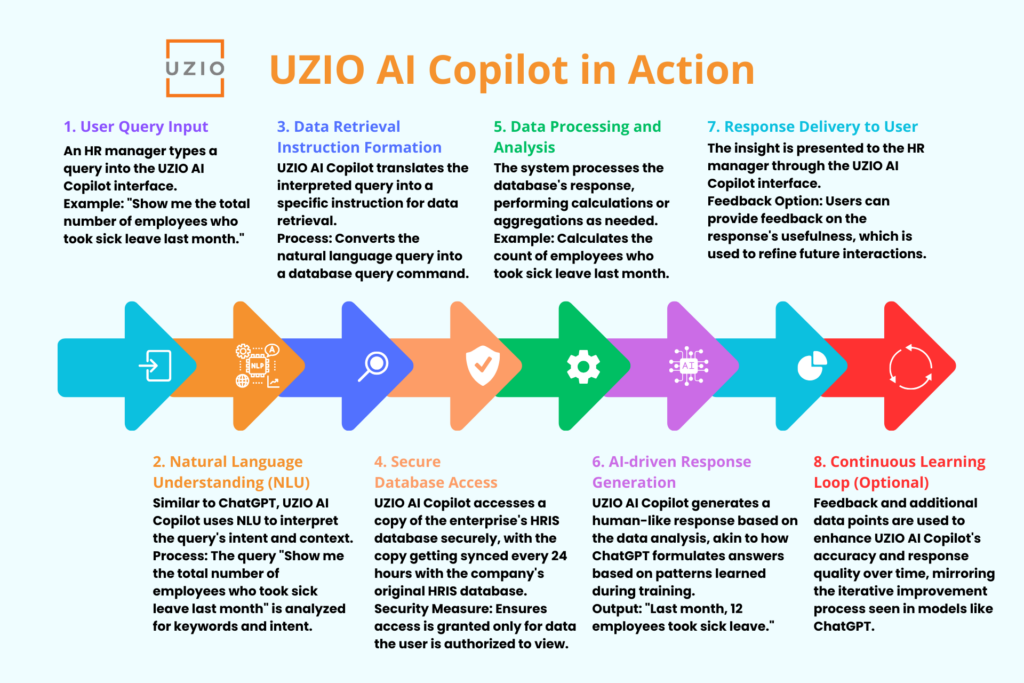
4. Unlocking the UZIO Copilot Advantage
Seamless Integration and Scalability
UZIO Copilot seamlessly integrates into existing HR systems, providing a smooth transition and a consistent user experience. Designed with scalability in mind, it grows with your business, ensuring that your HR operations remain efficient and effective without compromising performance.
Data Security and Compliance
In designing UZIO Copilot, paramount importance has been placed on ensuring data security and maintaining strict compliance. A fundamental aspect of this commitment is the sophisticated user access management within the tool. Every query processed by UZIO Copilot is meticulously vetted to ensure that it adheres to the defined access permissions for each user. This means that the tool only provides information that a user is authorized to access, mirroring the access controls established in the user interface. This safeguard prevents any potential misuse of the system, ensuring that sensitive information remains secure and accessible only to those with the appropriate permissions.
Further enhancing the security framework is UZIO Copilot’s method of interacting with enterprise data. The AI operates on a separate copy of the organization’s data, which is updated every 24 hours. This approach not only minimizes the load on the primary database but also adds an extra layer of security. In the unlikely event of any issue arising within the AI’s database, the primary enterprise data remains untouched and entirely secure. This architecture ensures that UZIO Copilot delivers its cutting-edge capabilities without posing any risk to the integrity and security of the organization’s data.
By integrating these robust security measures and compliance protocols, UZIO Copilot exemplifies a forward-thinking approach to data protection. Organizations can leverage the transformative power of AI with the assurance that their data is handled responsibly and securely, in full alignment with regulatory standards.
5. The Future of HRIS with UZIO
As we stand on the brink of a new era in HRIS, UZIO is at the forefront, championing a future where AI-first strategies redefine the landscape of payroll and HRIS software. Our journey towards becoming an AI-first payroll and HRIS solution is paved with a commitment to continuous innovation and a keen anticipation of how AI will transform HRIS in profound ways.
UZIO’s Commitment to Continuous Innovation
At UZIO, innovation is not just a buzzword; it’s the cornerstone of our approach to HRIS. We are dedicated to harnessing the power of AI to make HR and payroll management not only more efficient but also more insightful. Our vision for UZIO Copilot is to create a tool that evolves in tandem with the needs of modern workplaces, offering solutions that are both cutting-edge and deeply relevant to the challenges HR professionals face today.
The Anticipated Evolution of AI in HRIS
The landscape of HRIS is set to transform dramatically, with AI playing a pivotal role in shaping its future. UZIO Copilot is at the heart of this transformation, embodying our vision for an AI-first approach that brings unparalleled efficiency, accuracy, and strategic insight to HR and payroll management.
While specific details of our roadmap are part of our strategic planning, the direction is clear: UZIO Copilot will continue to expand its capabilities, addressing a wide range of HR functions from compliance and benefits to enrollment queries and beyond. Our aim is to build a comprehensive solution that not only answers the immediate needs of HR professionals but also anticipates future trends and requirements.
6. Conclusion
The UZIO AI Copilot era marks the beginning of a new chapter in HR and payroll management—one characterized by efficiency, accuracy, and intelligent decision-making. By embracing this AI-powered tool, businesses can not only address the limitations of traditional systems but also unlock new possibilities for innovation and growth. Join us in revolutionizing HR and payroll management with UZIO AI Copilot, and experience the future of HR technology today.
Get in touch with us for an expert-led demo to know more about UZIO all-in-one payroll software.
Revolutionizing HR and Payroll Management with AI: The UZIO AI Copilot Era
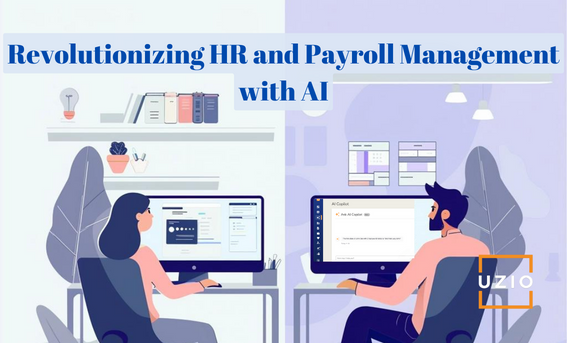
Quick links
-
Introduction
-
The Need for Innovation in HR and Payroll Management
-
Introducing UZIO AI Copilot
-
Key Features of UZIO AI Copilot
-
Transformative Benefits for HR and Payroll Management
-
Real-World Applications and Success Stories
-
Looking Ahead: The Future of HR with UZIO AI Copilot
-
Conclusion
1. Introduction
In the rapidly evolving world of business, HR and payroll management stand at a crossroads. Traditional systems, while reliable, often lack the flexibility and efficiency required by today’s dynamic workforce demands. Enter the era of artificial intelligence (AI) – a transformative force poised to redefine the landscape of HRIS and payroll management. At the forefront of this revolution is UZIO AI Copilot, a pioneering solution designed to usher in a new age of HR and payroll operations.
2. The Need for Innovation in HR and Payroll Management
For years, HR and payroll managers have navigated the complexities of employee management, compensation, and compliance using systems that, despite technological advancements, have remained fundamentally unchanged. The limitations of these traditional tools have become increasingly apparent, highlighting a critical need for innovation. The introduction of AI into this domain promises not only to address these challenges but to fundamentally transform the way HR professionals interact with their systems.
3. Introducing UZIO AI Copilot
UZIO AI Copilot is not just another HRIS tool; it’s a visionary leap into the future of HR and payroll management. Powered by sophisticated AI technology, UZIO AI Copilot is designed to understand and generate human-like responses to a wide array of HR-related queries. This groundbreaking tool stands as a testament to UZIO’s commitment to innovation, setting a new standard for what’s possible in HR technology.
Key Features of UZIO AI Copilot
- AI-Powered Insights: With UZIO AI Copilot, accessing detailed employee information, payroll data, and time-off requests becomes as simple as asking a question. The AI-driven engine processes queries in real-time, delivering accurate insights when you need them most.
- Efficient Query Handling: UZIO AI Copilot’s natural language processing capabilities mean HR and payroll queries are handled with unprecedented efficiency, transforming hours of work into minutes.
- Seamless Integration: It’s a native component of the UZIO platform, crafted to work in harmony with your enterprise data. This integration is seamless, tapping directly into the wealth of AI-driven insights without the need for external adjustments or additional integration costs.
- Intelligent Decision-Making: By providing data-driven insights and analytics, UZIO AI Copilot supports informed decision-making, enabling HR and payroll managers to strategize with confidence.
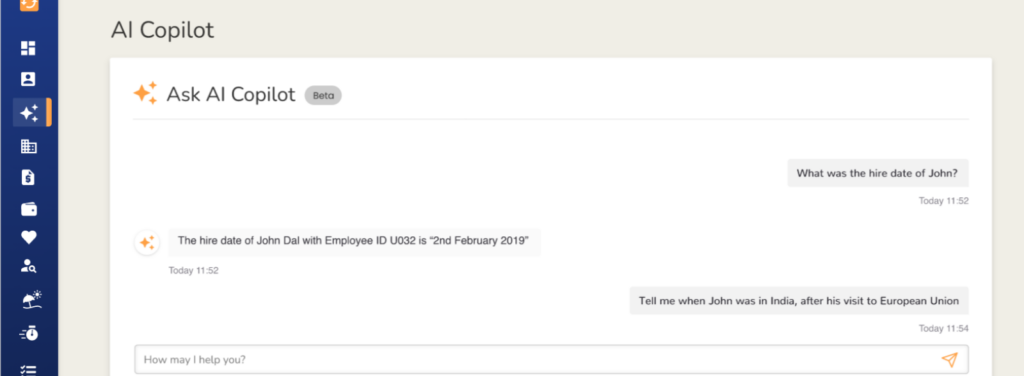
4. Transformative Benefits for HR and Payroll Management
The introduction of UZIO AI Copilot into HR and payroll processes brings a host of transformative benefits. Productivity sees a significant boost as routine inquiries are handled swiftly, allowing HR professionals to focus on strategic initiatives. Accuracy is enhanced, with AI-verified information reducing the potential for costly errors. Perhaps most importantly, the employee experience is improved, with quick and accurate responses to queries fostering a more engaged and satisfied workforce.
5. Real-World Applications and Success Stories
Automating Payroll Queries for Enhanced Accuracy and Efficiency
Scenario 1: XYZ Corporation
XYZ Corporation, a growing software development firm, faced challenges in managing payroll queries efficiently. Before UZIO AI Copilot, the payroll department was inundated with employee questions regarding tax deductions, bonus calculations, and overtime pay, leading to delays and occasional inaccuracies.
Implementation of UZIO AI Copilot:
After integrating UZIO AI Copilot, XYZ Corporation’s payroll team was able to automate the response process for common queries. For instance, when employees asked, “What was my total overtime pay last month?” UZIO AI Copilot instantly provided accurate figures by accessing the payroll database, significantly reducing the workload on the payroll department and increasing employee trust in the payroll process.
Optimizing Leave Management for Operational Efficiency
Scenario 2: The Global Hotel Chain
The Global Hotel Chain, with properties in over 50 locations, faced challenges in managing employee leave requests, leading to staffing shortages and operational disruptions. The manual process of tracking and approving leave was cumbersome and prone to errors.
Implementation of UZIO AI Copilot:
The introduction of UZIO AI Copilot transformed their leave management process. Employees could inquire about their leave balance or submit leave requests simply by asking, “How many vacation days do I have left?” or “I’d like to request vacation days for the first week of July.” UZIO AI Copilot processed these requests in real-time, notifying managers for approval and automatically updating the system. This led to a more streamlined operation, ensuring adequate staffing levels across all hotel properties and significantly improving employee satisfaction with the leave management process.
6. Looking Ahead: The Future of HR with UZIO AI Copilot
As we venture into the future, UZIO AI Copilot is set to redefine the landscape of HR and payroll management even further. Building on its current capabilities to answer complex departmental, payroll, and leave-related queries, UZIO AI Copilot’s roadmap includes an ambitious expansion of its question-answering prowess.
In upcoming releases, UZIO AI Copilot will delve into benefits and enrollment queries, offering precise insights into health plan enrollments, 401(k) contributions, and benefits participation rates. This evolution signifies a leap towards comprehensive employee benefits management, simplifying the intricacies of enrollment processes and financial contributions for HR departments.
Moreover, the horizon for UZIO AI Copilot includes enhancing compliance and safety oversight. From ensuring employees’ certifications are up-to-date to monitoring mandatory safety training completions, UZIO AI Copilot aims to become an indispensable tool for maintaining workplace safety and regulatory compliance.
But the vision doesn’t stop there. UZIO AI Copilot is poised to integrate publicly available data sources, enabling it to answer broader compliance questions related to state-specific labor laws, health insurance requirements under the ACA, and even guidelines for workplace safety standards. This expansion will equip HR professionals with the knowledge to navigate the complex web of regulations confidently, ensuring their organizations stay ahead of compliance curves.
As UZIO AI Copilot evolves, it promises not only to enhance the efficiency and effectiveness of HR and payroll management but also to empower organizations with a deeper understanding and strategic management of their workforce. The future of HR with UZIO AI Copilot is bright, marked by intelligent decision-making, seamless integrations, and a commitment to innovation that keeps pace with the changing world of work.
7. Conclusion
The UZIO AI Copilot era marks the beginning of a new chapter in HR and payroll management—one characterized by efficiency, accuracy, and intelligent decision-making. By embracing this AI-powered tool, businesses can not only address the limitations of traditional systems but also unlock new possibilities for innovation and growth. Join us in revolutionizing HR and payroll management with UZIO AI Copilot, and experience the future of HR technology today.
Get in touch with us for an expert-led demo. To know more about UZIO AI Copilot please click here.
Emerging Trends in Cannabis Consumer Preferences

Quick links
-
Introduction
-
The Modern Cannabis Consumer: A Diverse Tapestry
-
The Evolution of Purchasing and Consumption
-
Shift Towards Health and Wellness
-
The Popularity of Edibles and Drinkables
-
Concentrates and Extracts Gain Ground
-
Microdosing: A Growing Trend
-
Preference for Sustainable and Organic Products
-
Technological Innovations in Product Consumption
-
The Role of Branding and Product Diversity
-
Insights from the 2023 Cannabis Consumer Report
-
Conclusion
1. Introduction
The cannabis industry’s evolution is marked by rapid legalization, technological innovation, and changing consumer behaviors. As we delve into the nuanced preferences shaping the market, it becomes crucial to highlight key data points and insights that offer a clearer understanding of where the industry is heading.
The evolving cannabis market reflects a shift in consumer attitudes and an expansion of the consumer base. Understanding these preferences is vital for navigating the complexities of this dynamic industry.
2. The Modern Cannabis Consumer: A Diverse Tapestry
Beyond Stereotypes: The New Face of Cannabis Users
Forget the clichés—the average cannabis consumer cannot be boxed into a single archetype. Today’s users come from every walk of life, challenging outdated stereotypes and highlighting the mainstream acceptance of cannabis. This diversity is a testament to the plant’s universal appeal and its integration into various lifestyles.
The SECURE Act 2.0 builds on its predecessor’s foundation, aiming to further enhance Americans’ retirement savings landscape. Enacted to address the evolving financial needs of today’s workforce, this legislation introduces pivotal reforms designed to expand access to retirement plans, increase savings rates, and offer greater flexibility.
Understanding User Personas
- The Health-Conscious User: Turns to CBD-rich products, valuing therapeutic benefits over psychoactive effects.
- The Social Recreational User: Finds joy in sharing experiences, preferring social settings for cannabis consumption.
- The Wellness Enthusiast: Merges cannabis with wellness practices, embracing the plant as part of a holistic lifestyle.
- The Seasoned Connoisseur: Seeks out premium strains and products, deeply engaged in the nuances of cannabis culture.
3. The Evolution of Purchasing and Consumption
Navigating Consumer Preferences
Today’s cannabis consumers value convenience, quality, and information. Dispensaries that offer a broad product selection, competitive pricing, and knowledgeable service are capturing the market. However, despite the emergence of brands, the deciding factors remain price and quality, challenging the notion of brand loyalty.
Diverse Methods of Consumption
- Smoking: The traditional favorite, valued for its immediacy and familiarity.
- Edibles and THC-Infused Beverages: Gaining popularity for their convenience and variety.
- Topicals: Sought after for localized relief without the high.
- Dabbing: Preferred by those in pursuit of potency and purity.
The Informed Consumer
Cannabis users today do their homework, often researching products and dispensaries online before making a purchase. This trend highlights the importance of a robust online presence and educational content for dispensaries.
4. Shift Towards Health and Wellness
The health and wellness trend is underscored by a growing interest in CBD-dominant products, with consumers increasingly seeking cannabis for its therapeutic benefits without the psychoactive effects. This shift is part of a broader trend towards wellness-oriented lifestyles, integrating cannabis into daily wellness routines.
-
Increasing Interest in CBD-dominant Products for Health Benefits
Consumers are turning to CBD-dominant products for their potential to alleviate various health issues without inducing a high, marking a significant shift in consumption patterns towards health-oriented choices.
-
The Rise of Cannabis as a Wellness and Lifestyle Product
Cannabis is being embraced as a holistic wellness product, evident in its incorporation into beauty products, yoga, and meditation practices, reflecting its acceptance and versatility as a lifestyle enhancer.
5. The Popularity of Edibles and Drinkables
Edibles and cannabis-infused beverages are gaining popularity for their convenience and sociability. These products cater to a broad audience, offering diverse tastes and preferences in the form of gummies, chocolates, sodas, and teas.
-
Growth in the Edibles Market: Types and Preferences
The edibles market is expanding, with consumers showing a strong preference for gummies and chocolates. This trend reflects a demand for innovative and accessible cannabis solutions.
-
The Emergence of Cannabis-Infused Beverages
Cannabis-infused beverages are carving out a niche, offering a novel, social way to consume cannabis. These products appeal to those seeking alternatives to alcoholic drinks, emphasizing the trend towards healthier lifestyle choices.
6. Concentrates and Extracts Gain Ground
The demand for concentrates and extracts is rising, with products like shatter, wax, and oil appealing to consumers seeking purity and potency. This trend highlights the market’s shift towards high-quality, specialized products.
-
The Rising Demand for Concentrates and Extracts
Concentrates and extracts are increasingly popular for their high potency and purity, catering to a segment of consumers looking for intense experiences and specific benefits.
-
Different Forms of Concentrates and Their Uses
The variety of concentrates available allows consumers to choose based on their preferred consumption method, whether vaporizing, dabbing, or incorporating into edibles, highlighting the personalized nature of cannabis consumption.
7. Microdosing: A Growing Trend
Microdosing is becoming popular as it offers a way to enjoy the benefits of cannabis without the intense effects. This method appeals to both new and experienced users, indicating a shift towards more controlled, subtle consumption practices.
-
What is Microdosing and Why is it Becoming Popular?
Microdosing involves taking small, controlled doses of THC, allowing users to achieve a desired level of clarity and productivity without overwhelming psychoactivity, catering to those seeking to integrate cannabis into their daily routines responsibly.
-
Benefits of Microdosing for New and Experienced Users
The benefits of microdosing include enhanced focus, creativity, and mood, with minimal adverse effects. This approach is appealing for its ability to tailor the cannabis experience to individual needs and lifestyles.
8. Preference for Sustainable and Organic Products
As environmental consciousness grows, so does the demand for organic, sustainably grown cannabis. Consumers are increasingly seeking transparency in cultivation practices, favoring products that align with their environmental and health values.
-
Consumer Interest in Organic, Sustainably Grown Cannabis
The shift towards organic, sustainably grown cannabis reflects a broader trend in consumer goods, emphasizing the importance of environmental stewardship and health-conscious choices in the cannabis industry.
-
Impact on Cultivation Practices and Product Labeling
This consumer preference is driving the industry towards more sustainable cultivation practices and clearer product labeling, allowing consumers to make informed decisions based on their values and the environmental impact of their purchases.
9. Technological Innovations in Product Consumption
Technological advancements are reshaping cannabis consumption, with innovations in vaping technology and product delivery systems offering safer, more efficient methods. This evolution influences consumer preferences by emphasizing convenience, safety, and experience.
-
Advances in Vaping Technology and Product Delivery Systems
Innovations in vaping and delivery systems reflect the industry’s response to consumer demand for more sophisticated, user-friendly cannabis experiences. These technological advancements are setting new standards for convenience and efficacy in cannabis consumption.
-
How Technology is Shaping Consumer Preferences
Technology not only expands the possibilities for cannabis consumption but also shapes consumer expectations. As new technologies emerge, consumers are increasingly seeking products that offer enhanced safety, precision, and convenience.
10. The Role of Branding and Product Diversity
In the competitive cannabis market, effective branding and product diversity are critical for attracting and retaining consumers. Brands that communicate quality, safety, and values resonate with consumers, fostering loyalty and differentiation.
-
The Importance of Branding in the Cannabis Industry
Branding is crucial in the cannabis industry, helping companies stand out and build trust with consumers. Effective branding strategies communicate the quality and uniqueness of products, aligning with consumer values and preferences.
-
How Product Diversity is Meeting the Needs of Various Consumer Segments
The wide range of cannabis products available reflects the industry’s commitment to catering to diverse consumer needs. From flowers to concentrates to topicals, the diversity of products enables consumers to find the best fit for their preferences and lifestyles.
11. Insights from the 2023 Cannabis Consumer Report
Here are some of the key insights form the Cannabis Consumer Report 2023. This repost also corroborates our findings.
- Daily Usage: 48% of users consume cannabis daily, with 78% planning to maintain or increase their consumption.
- Preference for Smoking: Despite the popularity of edibles, smoking remains the preferred method.
- The Deciding Factors: Price and quality are paramount when choosing a dispensary.
- Mental Health and Social Benefits: A significant majority report positive effects on mental health, happiness, and social interactions.
12. Conclusion
The cannabis industry is characterized by its rapid growth, evolving consumer preferences, and the continuous innovation shaping its future. From health and wellness trends to technological advancements, understanding these dynamics is crucial for anyone navigating the cannabis space. As the market expands, staying informed about these trends will be key to making informed decisions, whether for personal use or business strategy.
Get in touch with us for an expert-led demo to know more about UZIO all-in-one payroll software.
Navigating the Future: A Quick Glance into the SECURE Act 2.0

Quick links
-
Introduction
-
A New Era for Retirement Planning
-
Preparing for Change
-
Conclusion: Embracing the Future of Retirement Planning
1. Introduction
The landscape of retirement planning in the United States is on the brink of significant change, thanks to the introduction of the SECURE Act 2.0. As professionals navigating these waters, it’s crucial to understand how these updates will reshape strategies for saving for retirement. Let’s break down the essentials of the SECURE Act 2.0 and explore its implications for both individuals and employers.
2. A New Era for Retirement Planning
The SECURE Act 2.0 builds on its predecessor’s foundation, aiming to further enhance Americans’ retirement savings landscape. Enacted to address the evolving financial needs of today’s workforce, this legislation introduces pivotal reforms designed to expand access to retirement plans, increase savings rates, and offer greater flexibility.
Expanding Access to Retirement Plans
- Empowering Small Businesses: The Act introduces incentives, making it easier and more affordable for small businesses to offer retirement plans. This move aims to level the playing field, ensuring employees of smaller entities have access to the same retirement benefits as those in larger corporations.
- Welcoming Part-Time Workers: By simplifying eligibility criteria, the SECURE Act 2.0 ensures that more part-time workers can participate in employer-sponsored retirement plans, marking a significant step towards inclusive savings opportunities.
Boosting Retirement Savings
- Enhanced Catch-Up Contributions: For those aged 50 and above, the Act increases catch-up contribution limits, offering an opportunity to significantly bolster retirement savings in the run-up to retirement.
- Rethinking Required Minimum Distributions: By delaying the age for required minimum distributions, the Act allows individuals to grow their retirement savings for longer, adapting to modern realities of longer lifespans and working years.
Innovating with Lifetime Income Options
- Promoting Annuities: The SECURE Act 2.0 encourages the inclusion of annuity options within retirement plans, providing a pathway to secure, lifelong income streams in retirement.
- Portability of Investments: Addressing the modern workforce’s mobility, the Act ensures that individuals can transfer their lifetime income investments between plans without penalties, preserving their retirement income security.
Emergency Savings and Student Loans
- Emergency Savings Accounts: For the first time, the Act allows for the creation of emergency savings accounts linked to retirement plans, offering a safety net that doesn’t compromise long-term savings.
- Integrating Student Loans: Recognizing the burden of student loans, the Act permits employers to make matching contributions to retirement accounts based on employees’ student loan payments, blending debt repayment with retirement savings.
For Employers: Navigating New Terrain
Employers must adapt to these changes, considering the implications for plan administration, compliance, and employee benefits strategies. The Act’s provisions necessitate a comprehensive review of existing retirement offerings and potentially, the introduction of new plan features to enhance employee benefits.
Individual Implications: Planning with Precision
Individuals must take stock of how the SECURE Act 2.0 affects their retirement strategies. From maximizing new catch-up contributions to understanding the impact of delayed RMDs, the Act offers numerous opportunities—and some challenges—for personal retirement planning.
3. Preparing for Change
Both employers and individuals need to prepare for the SECURE Act 2.0. Employers should consult with service providers to ensure their plans comply with the new legislation, while individuals might benefit from discussing the changes with a financial advisor to adjust their retirement planning strategies accordingly.
4. Conclusion: Embracing the Future of Retirement Planning
The SECURE Act 2.0 represents a transformative shift in the retirement planning landscape, introducing measures that acknowledge and adapt to the changing financial needs of the American workforce. As we move forward, staying informed and proactive is key to leveraging these changes for a secure and prosperous retirement.
Get in touch with us for an expert-led demo to know more about UZIO all-in-one payroll software.